| Main page » Polish armour » tanks » Vickers Mk. E » part I – Polish artillery – Steel Panthers – what's new | 
| ||
| © Michal Derela, 2003 | Updated: 28. 3. 2023 | ||
| Main page » Polish armour » tanks » Vickers Mk. E » part I – Polish artillery – Steel Panthers – what's new | 
| ||
| © Michal Derela, 2003 | Updated: 28. 3. 2023 | ||
Part I: Development history and construction
Part II: International service
Part III: Polish service
 |
Development history – Designations – Mark F tank – Special variants – Description – Specifications
One of the most significant tanks in the history of armoured weapons was the British light tank Vickers Mark E , also known as the Vickers 6-Ton. Paradocsically, it seems also to be one of the most forgotten tanks – apparently because it was used in small numbers, on less 'popular' war theatres, and not by major powers of World War II. As a result, despite its origin, it is usually omitted in reviews of British tanks. However not appreciated by the British Army, the Vickers 6-Ton made an impressive international career. Despite a number of produced tanks was not big, but it arguably was the most modern tank produced in the beginning of 1930s, and the most widespread tank in the world before World War II after obsolete Renault FT. Moreover, its licence gave birth to 12,000 tanks of the Soviet T-26 family and to the Polish 7TP tank.
Note: links marked this way lead to Wikipedia articles.
A prototype of the Vickers-Armstrongs 6-Ton (Mark E) light tank was constructed in 1928 in the British Vickers-Armstrongs Ltd factory, as a private venture. Among its designers were famous John Carden and Vivian Loyd. The tank was designed in two variants: a twin-turret Type A (Alternative A), armed with two machine guns, and a single-turret Type B (Alternative B). The novelty in the world was, that Type B tank was armed with a cannon and a co-axial machine gun in the turret (called a "duplex mounting" at that time). Earlier tanks and armoured cars were either armed with only one weapon, like Renault FT family, or with two weapons placed in separate mountings (and sometimes different sides of a turret), which could not be manned by one man at a time. Some tanks also had machine guns in hull sides, which were of little use, but demanded big hull volume and additional crewmen. The duplex mounting, which now seems obvious arrangement, allowed instant change between a cannon or a machine gun fire, depending on a target engaged. Both weapons had common sights and a trunnion axis and could be elevated and traversed together. According to Vickers sales brochures, with the duplex mounting, fire can be opened with Armour Piercing or High Explosive shell from the quick firing gun against the tank or machine gun emplacement, and can be followed immediately by fire from the machine gun without a necessity for relaying. Also thanks to a two-men turret, the commander was not overloaded with tasks, unlike in French tanks from 1930s. With its short-barrel 47 mm cannon, Mark E Type B tank offered quite good firepower, especially with HE shells, but also adequate to fight all contemporary tanks. Despite its armour showed later as inadequate, at the moment of design it was even better, than of a standard British Vickers Medium Mk II tank. It carried a cannon of the same caliber, shorter, but more universal thanks to HE shells. The Mark E was also smaller and faster, than the Medium tank. Its patented suspension was a new design, consisting of two independent sets of double bogies on each side, fitted with cantilever springs. Each suspension unit pivoted on its own axle. It was quite simple, reliable and offered a relatively smooth ride. Manganese steel small-link tracks had a very good durability of 3000 miles.
The process of designing and building prototypes of the Vickers 6-Ton tank has not been described in publications in a complex way and in detail so far. It is known that the first sketches of the 6-ton tank were presented to the Polish delegation in February 1928. The prototype of a twin-turret tank (Type A) was built that year, and a single-turret tank (Type B) followed in 1930. The first prototype had an 80 hp Dorman water-cooled gasoline engine in a high compartment at the rear. It also differed from production tanks in a vertical plate in front of the driver and a shape of suspension arms, with lightening holes. In the end, however, it was decided to use an 80 hp Armstrong-Siddeley air-cooled four-cylinder engine in a horizontal arrangement, which allowed the use of an extremely low, and thus less of a target, engine compartment (such a low engine compartment was not seen in any other tank design afterwards). At the turn of the 1920s and 1930s, the tank was tested by the British Army, but was rejected because its innovative suspension was met with a suspicion and considered to be a weak element in the design. This decision, however, opened the possibility of offering the 6-Ton tank to foreign buyers, under the export designation: Mark E. It is noteworthy, that initially it was considered a medium tank, and received a designation following its bigger export predecessors Mark C and D. The tank was officially presented at the fair in London in 1930.
Due to a wide advertising, in 1930-1940 years these tanks were bought by (in chronological order): USSR, Greece, Poland, Bolivia, Siam, Finland, Portugal, China and Bulgaria. Most customers chose the single-turret version, while the twin-turret one was bought only by the USSR, Poland, and single units by Greece, Bolivia and Portugal. Single tanks were also tested in several other coutries. Most of the exported tanks saw combat service during their lifetime. After all, these tanks also ended up in the British army, because in 1939 the British government took over four Mk.E tanks from Siam's orders, which were then used for training. According to some information, Vickers works in Elswick manufactured 153 tanks Mark E[2]. There are known 142 tanks sold abroad, and several were also used for a demonstration purpose by the manufacturer. Despite it was not a great number, but the USSR and Poland bought a licence to manufacture Vickers Mk.E. Basing on it, the USSR produced over 12,000 tanks of the T-26 family, while in Poland the 7TP tank was developed (over 130 built). Such a success resulted both from a modern construction and Vickers efficient sales promotion. However, in early 1930s, the tank was worth it and had not much real competition. Despite more modern tanks were designed in the world from mid-1930s, the Vickers Mk. E retained a real combat value until the beginning of World War II. Its 47 mm gun, though obsolete, was still capable of destroying most of early WWII tanks at a short, or even a medium distance. Only its armour showed completely insufficient due to a development of anti-tank guns and even automatic cannons.
The Vickers Mk.E design features, especially its suspension, influenced several world's tank designs, including Italian medium tanks from M-11/39 through M-13/40 to P-40, and Czechoslovak Škoda LT vz.35 (later PzKpfw-35(t)) and T-21 (later Hungarian Turan). A common opinion, that their suspension was copied from the Vickers, is obviously false – however, apparently in order to overcome the Vickers patent, all these tanks used twin suspension arms with two-wheel bogies, sprung by fixed semi-elliptical springs, instead of single cantilever assemblies with twin two-wheel bogies and integral springs. Less known fact is, that the French SOMUA S-35 had similar suspension with twin arms as well. The Renault FT was the first tank with a classic compact arrangement of driver, combat and engine compartments in line, but the Vickers Mk. E moved this idea further forward, and many tanks adopted its arrangement of transmission, with a drive shaft going through the combat compartment to a gearbox and sprocket wheels in front. A majority of tanks built afterwards adopted some kind of the duplex mounting of weapons in one turret as well – and it is noteworthy, that modern tanks also have all weapons and all crew members, save a driver, in a turret.
Sources from that period mentioned, that there existed also Mark E Type C, armed with two unknown 37 mm cannons in the combat compartment, shooting forward and rearwards, but there are not known any photographs and most probably such version was never built. It might have been proposed for potential clients, but there were no orders[note 1].
 |
| Vickers Mark F prototype |
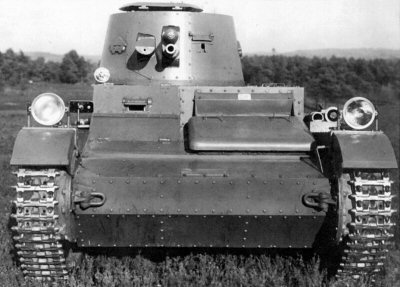 |
A projected development of Mark E tank was the Mark F, developed in 1934 for Belgium. One of Mark E faults, confirmed in Poland, was its overheating and rather weak air-cooled engine Armstrong-Siddeley. The original Mark E Type B tank had a turret offset to the left of the combat compartment, because there was a driver seat on the right. In Mark F tank, a new water-cooled six-cylinder inline engine Rolls-Royce Phantom II was fitted (according to some sources, its power output was 125 HP). Because it would not fit at the rear, where the old Armstrong-Siddeley engine went, the engine was placed on the left side of the combat compartment, which is why the turret had to be moved to the right. Because of the driver's seat, the turret was placed behind the driver, what demanded lengthening of the combat compartment from around 125 to 167 cm. On the left side of forward upper hull plate, before the engine, there was added a big air inlet, covered with an armoured roof with rolled edges, to protect against Molotov cocktails. A water radiator was placed under the upper rear hull plate, inclined at a greater angle to the horizontal, than in the Mark E. Only one prototype of the Mark F tank was built and tested in Belgium, but rejected.
However the Mark F tank did not enter production, but late production Mark E tanks (1937-40) were fitted with such modified hull, merged with original horizontal Armstrong-Siddeley engine at the rear. Such tanks had a lengthened combat compartment, but since the engine remained the same length, the combat compartment extended to the rear above the engine compartment (a bulkhead separating compartments was vertical at a bottom and sloping back in an upper part). Also the upper rear plate was inclined at a greater angle. According to Soviet tests, the frontal and side armor of the hull was reinforced to 17.5 mm (what is not covered in popular publications). It is noteworthy, that tanks produced for Finland had the turret moved to the right rear part of the combat compartment (as in the Mark F design), however tanks produced for Siam and Bulgaria had the turret in its original place, on the left side, in the front part of the combat compartment. The reason for using the new hull instead of just thickening the armour of the original, slightly smaller and lighter hull, is not covered in publications. A hint may be, that in Polish evaluation, the combat compartment of the original tank was described as rather cramped. The publications also do not mention why the tanks had different turret placement – we can suspect that Finnish Army wanted tanks with a turret on the right side, if it was already planning to add the fourth crew member at this stage, to operate the Suomi submachine gun mounted in the front plate. Sometimes tanks with new hulls are called: "Mark F" in publications, but this is incorrect (the hull itself might be referred to as Mark F eventually, for a sake of convenience).
As early as in 1928, there was an universal Vickers Medium Gun Tractor designed on the Vickers 6-ton tank chassis. It was meant for military and civilian market as well. It was tested with the Dorman engine in a tall rear compartment as well as with horizontal Armstrong-Siddeley engine. The British Army evaluated the tractor between 1930 and 1932, but finally rejected it. In 1932 one vehicle was bought by the German company Siemens-Schuckert.
In 1934, Vickers developed an improved bigger artillery tractor on the same chassis, powered by a stronger Diesel AEC 90 hp engine, and housing also the gun crew. The British Army ordered 12 tractors, with a designation: Medium Dragon Mk.IV. Series production vehicles were fitted with modified stronger suspension assemblies (analogous ones were fitted in new British Army infantry tank A11 Matilda). They were given to one of heavy artillery regiments and used for towing 60-pdr guns (127 mm). In 1939, they were sent to France with the British Expeditionary Force, where they were seized by the Germans during a retreat to Dunkirk. Small series of artillery tractors were also exported: in 1935 China bought 23 tractors and in 1937 India bought 18 tractors.
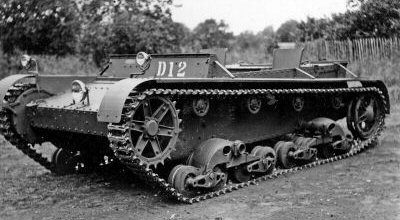 |
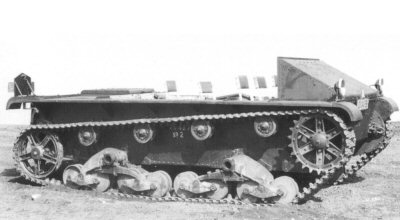 |
| Vickers Medium Gun Tractor prototype with Armstrong-Siddeley engine (visible is the earliest suspension) | Medium Dragon Mk. IV tractor prototype without built-up walls |
 |
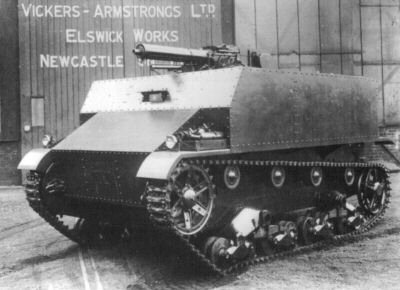 |
| Medium Dragon Mk. IV tractor (note a different suspension) © Crown copyright: IWM (MH 8407) | Vickers-Armstrongs 40 mm SP AA gun |
 |
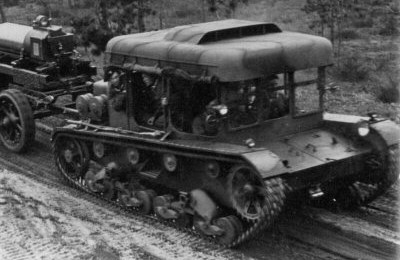 |
| The Soviet T-26T tractor with a canvas top | The Polish C7P tractor |
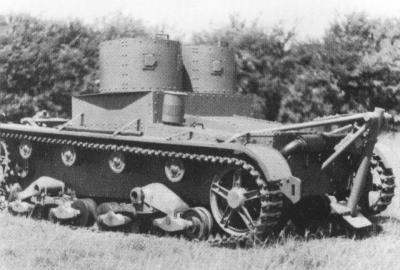 |
On the chassis of the Medium Dragon artillery tractor, a self-propelled anti-aircraft gun was also developed by Vickers-Armstrongs. 26 such vehicles were produced for Siam. The vehicle had an open superstructure, with 40 mm (2 pdr) Vickers automatic AA gun ("pom-pom") mounted, with a rate of fire 120 rds/min. It was probably the first tracked armoured SPAAG in the world produced in series, although such guns were mounted on wheeled armoured chassis already during World War I.
Own artillery tractors, basing on the licensed Vickers 6-Ton chassis, were also developed and produced in the USSR and Poland. In the USSR there were built 197 T-26T tractors, in a basic unarmoured variant with canvas sides of a crew compartment, and less numerous armoured variant with a closed superstructure. In Poland there were built approximately 151 unarmoured C7P tractors, with Diesel engine and a superstructure with a massive roof and canvas sides. In the USSR, there were built also small series of tank bridgelayers ST-26 and 122 mm SP-howitzers SU-5-2 on T-26 chassis. Also several prototypes of other SP-guns, armoured carriers, engineer tanks and other special variants were built.
For the Vickers Mk. E tank, enginer N. Straussler designed a special trench-crossing gear. It was a lever device, which allowed tank to cross wide trenches. It was advertised by Vickers, but in practice it appeared impractical and unsuccessful (a photo on the right, probably of the British tank evaluated in Poland – note observation slots with flaps and a can oil cooler, used on some tanks).
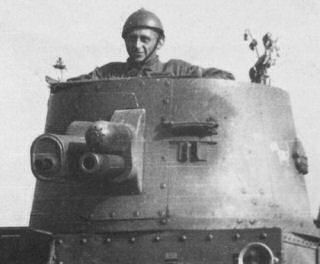 |
| Polish Vickers Mk E Type B turret. A gun sight hole is visible, with an observation slot above, covered with a hatch (a full scene) |
 |
| Polish Vickers Mk E Type B turret evaluated in the USSR. Note removed additional front plate and side vision slot cover |
Vickers Mark E tanks might have different machine guns fitted, according to buyer demands. A typical armament of twin-turret Type A tanks were two water-cooled Vickers 7.7 mm (.303) machine guns in rectangular gimbal mountings. Such arrangament made possible firing at infantry on both sides of the tank, especially when crossing trenches. Water radiators of machine guns could be protected with armoured cylindrical covers. In export version different machine guns were used, eg. 7.65 mm Vickers for Bolivia and 7.92 mm Vickers for Greece. Ammunition was 6000 rounds, or 4000 rounds when fitted with a radio (apparently only one Soviet tank was fitted so). The producer also envisaged usage of 12.7 mm (.50) Vickers tank machine gun, but such variant was not ordered, and probably even not built.
Polish twin-turret tanks underwent several armament changes, and used air-cooled 7.92 mm wz. 25 Hotchkiss, water-cooled 7.92 mm wz. 30 (Browning copy), and temporarilly 37 mm SA Puteaux short-barrel cannon or 13.2 mm wz. 30 Hotchkiss machine guns (see more on Polish service page). As the only Six-Ton tanks, they had universal ball weapon mountings and sticking out 13.2 mm armoured magazine covers.
The main armament of the single-turret Type B was a short-barrel tank cannon 47 mm Vickers QF L/21 mounted in the duplex mounting with a coaxial water-cooled machine gun. Both weapons were mounted in separate rounded mantlets elevating in two vertical openings of the front turret plate, protected with an additional external armour plate, doubling protection is some points. To the left of the cannon there was a telescopic sight, in a small opening of the armoured plate. There were used different machine guns, like in the Type A – mostly Vickers machine gun variants, but Polish tanks were fitted with own 7.92 mm wz. 30 machine gun, while Bulgarian ones had 8 mm Schwarzlose. There were several shapes of armoured covers for machine gun barrels; among others Siamese and Greek tanks had distinctive slender covers with a slanted front plate. A standard ammunition stock according to the manufacturer was 50 anti-tank and high explosive shells for the cannon, and 4000 machine gun rounds. Only late series tanks built for Finland were delivered with different turrets without any cannons, and later armed with 37 mm Bofors guns (see in part II).
The armour was made of riveted rolled plates, 5 to 13 mm thick. Late series tanks with Mark F hulls had frontal and side and rear combat compartment armour 17.5 mm. Armour thickness of main production tanks:
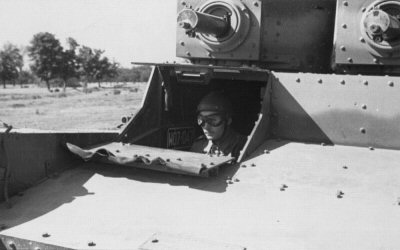 |
| A driver in an open hatch of the Polish Vickers Mark E Type A. Visible is armour thickness and rarely seen dust sealing of the hatch. A Polish license plate of 1937 pattern is carried inside. |
Hull:
Turrets:
According to Russian tests, thickest plates had actual thickness 12.7 mm (.50 in) and 9.8 mm and were made of cemented steel of a "good quality", while 5 mm plates were made of homogenous steel of a poor quality. In tanks made for Poland, 13 mm armour plates were found to be of poor quality, with less resistance, than specified. Also 5 mm floor plates were cracking under engines.
The tank's design layout was classic, with a transmission compartment in front, a combat compartment with a turret or turrets in the middle, and an engine compartment in the rear. The engine compartment was separated by a bulkhead with openings. The hull was made of armour plates, riveted to a frame – only part of upper plates were screwed and could be removed. The crew was three. The driver's seat was in front of the combat compartment, on the right side. Before the driver there was a large two-part hatch, only 10 mm thick, with a vision slot with a periscope in it (possibly part of tanks had no periscope). Vision from the driver's seat in combat conditions was poor, and he had no means of observation to the sides (only Finnish tanks were fitted with side vision slots there). Lower hull sides were vertical, built of three plates corresponding with hull compartment division (thickness 13 to 8 mm). The combat compartment above the lower hull was protected with 13 mm plates from all sides (increased to 17.5 mm in late tanks), save the driver's hatch. The combat compartment width was 1630 mm (64 in), and length approximately 1250 mm (49 in) according to plans.
Turrets: above the combat compartment there were two identical small one-man cylindrical "dustbin" turrets (Type A) or one large truncated cone turret (Type B). Turrets of the twin-turret version had an inner diameter of 864 mm (the bearing diameter was slightly smaller), and the single-turret Type B had an inner diameter of 1295 mm (50 in). In the twin-turret version, the commander (on the right) and gunner sat on suspended fabric belts or bicycle-type saddles and had individual forward-opening hatches in the roof with counterweight levers. Type B tanks had the turret shifted to the left, with the exception of tanks for Finland, which had turrets on the right. Some Type B tanks (for China and Finland) had turrets with a rear niche for the radio set. The crew members had suspended saddles in the turret, and the gunner on the left had a seat with a footrest and a foot-operated gun trigger. Publications differ on how crew members were assigned to the turret, but it seems that the commander typically was also the loader and sat on the starboard side, under a hatch[note 3]. Contrary to early factory drawings, most (if not all) single-turret tanks had a two-piece roof hatch instead of a single round one. With the exception of Finnish tanks, this hatch was protruding above the roof, with a ventilation slot under its folded edges, in most tanks located on the right side of the roof. Some tanks had a two-part hatch closer to the left side of the roof, most notably Chinese ones fitted with a radio. Both turrets were rotated by a manual gear. Turrets of the single-turret version had a telescopic sight hole to the left of the cannon, and a horizontal slit above it, closed by a flap. Single turrets also had three sliding observation slots, on the right front and rear, and on the left side, spaced at 120° angle to each other. The turrets of the twin-turret version had two sliding slots in the rear part in the standard variant, but the tanks for the USSR had no slots, and the Polish ones had four non-sliding slots with periscope inserts.
Tanks for Finland with Mk. F hull had slightly different turrets (perhaps Bofors design?), with a different division of plates, a niche for a wide gun mantlet in the front, a flat two-piece hatch in the roof symmetry axis, partially overlapping the rear niche, a ventilation gap around the roof edge below the upper edges of the walls, and two side periscopes. According to Soviet measurements, the internal diameter of the turret at the base was 1320 mm, tapering upwards to 1110 mm. Its walls had a slope of 10°.
Engine: Armstrong-Siddeley carburettor engine, located at the rear of the fuselage in a low engine compartment (in publications the model is often called "Puma", but it is not known if such name was actually applied). The engine was four-stroke, four-cylinder, in-line, overhead valve, horizontal, air-cooled. Displacement was 6667 cm³[1] or according to other sources, 6600 cm³[7]. The cylinder diameter was 120 mm, the piston stroke was 146.5 mm. The engine developed a nominal power 80 hp at 2000 rpm, and a maximum power 82 hp at 2100 rpm. One Polish document claims a power output 92 hp at 2000 rpm, which seems to be a mistake. The compression ratio was 4.8:1. The engine was fitted with a double-barrel Clodel-Hobson H.48A carburettor. The weight of the engine was 545 kg. Two fuel tanks on the right side of the engine compartment had a capacity of 182 liters. The engine was mounted longitudinally, in the center of the fuselage, with the cylinders facing left and the clutch at the front. Cooling air entered through a rectangular opening above the engine in the center of the top plate, with adjustable louvers. The air was drawn in by a fan located under the engine, then exhausted through an opening on the left rear side of the top plate, often shielded by a sheet metal hood directing it to the rear. There was also an oil cooler directly below air intake louvers. In some tanks, the oil cooler was placed in a perforated armored box on the left side behind the combat compartment.
Transmission: dry multi-disc main clutch, articulated drive shaft running through the center of the fighting compartment. Mechanical gearbox, four forward gears with ratios from 4.12:1 to 1:1. A special off-road gear was also available, with a ratio of 9.73:1, forward or reverse. Side clutches with band brakes.
Suspension: 23-tooth drive wheels were at the front, adjustable idler wheels at the rear. The distinctive patented Vickers paired bogie-type suspension consisted of eight double wheels on each side, paired in two-wheel bogies. Two bogies formed one common unit, sprung with a pair of flat springs. Each suspension unit pivoted on its own axle. Twin road wheels, 305 mm in diameter, were steel with rubber rims, except for last wheels, which were all-steel and rimless (apart from the earliest tanks). One track had 108 links (there is also an information about 102-103 links)[note 4]) Track width was 230 mm, pitch: 92 mm. There is an information, that some series had tracks 260 mm wide, and at least in the case of Finnish tanks they were widened to 290 mm. Track ground length was 270 cm, track center spacing: 204 cm. Four return rollers on each side.
Electric wiring was single-wire, 12 V[4]. Tanks had a dynamo Lucas C 575, batteries and an electric starter. There were two headlights on fenders, and according to part of publications, a red rear light on the left side (however, we can't find it on photographs). Typically, there was a dismantled hydraulic jack stowed on left fender. The tanks with a turret niche (for China) were fitted with Marconi SB4a radio; tanks for Finland were fitted for, but not with a radio. Twin-turret tanks could also have been fitted with Marconi radio (as far as it is known, only one tank for the USSR was fitted so).
| Twin-turret Vickers Mark E in the USSR: front and back | 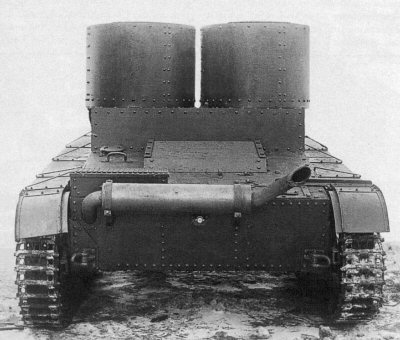 |
 |
There are different specifications in publications, especially as for weight and width. The data below are taken primarilly from [1]. The data refer first of all to single-turret Type B:
| Type B | Type A (if different) | |
| Crew | 3 | |
| Combat weight | 7350 kg | 7200 kg |
| Net weight, without an armament | 6655 kg | |
| Length /with fenders and a muffler | 454.6 /487.7 cm (179.5 /192 in) | |
| Length over tracks | 450 cm (177.2 in) | |
| Width | 241.3 cm (95 in) | |
| Width between fenders' edges | 228.6 cm (90 in) | |
| Height | 215.9 cm (85 in) | 208.3 cm (82 in) |
| Ground clearance | 38.1 cm (15 in) | |
| Distance between tracks' centres | 203 cm (80 in)[note 5] | |
| Track ground length | 270 cm (106.3 in) | |
| Max. road speed | 35 km/h (22 mph) | |
| Road / off-road range | 160 / 90 km | |
| Wading depth | 90 cm | |
| Max. steepness | 45°[note 6] | |
| Crossing ditches | 183 cm | |
| Crossing walls | 76 cm | |
| Weight to power ratio | 12.8 HP/ton | |
| Ground pressure | 0.48 kg/cm² | |
| Fuel consumption (road - off-road) | 110 - 200 litres/100 km |
Notes:
1. J. Ledwoch confabulates, that Type C was supposed to be a kind of "tank destroyer", armed with two 37 mm cannons in twin turrets. Heigl almanac from that period mentions on the other hand, that Type C was to be armed with two 37 mm cannons in the combat compartment, shooting forward and rearwards. This information seems little credible, because there were no tank 37 mm cannons produced in Great Britain, and there are not known any photographs nor drawings. It might have been proposed for potential clients, but certainly such variant was not built. Ledwoch's thesis, that it was to be a twin-turret version, is illogical, because available 37 mm cannons like French 37 mm SA Puteaux would not need any substantial changes from Type A, while small turrets would not embrace bigger cannons with better performance.
2. The publications usually describe only turret's all around armour 13 mm, disregarding additional external plate covering weapons' mountings. According to armour scheme in [5], it was also 13 mm thick, and as a result it doubled armour thickness in a small area. There is a possibility, that the plates were .50 in thick in fact (12.7 mm), as Russian sources suggest.
3. The publications differ, whether the commander was a loader and had a place on the right side, while the gunner was on the left side [7], or the commander was the gunner on the left side [5]. It seems more plausible, that the commander was the loader, because there was a hatch on the right side in most versions, and such was the British practice. It also might have differed according to the user.
4. According to J. Korbal [5], the track had 108 links, and the information about 102-103 links, met in some sources, is wrong.
5. In some publications there is wrong distance between tracks 229 cm. According to scaled factory plans it was 203 cm (80 in), while 228.6 cm (90 in) was a width between outer edges of fenders, and 241.3 cm (7 ft 11 in) was maximum width (between suspension units).
6. There is often quoted maximum steepness 37°, but according to factory drawings, the tank could negotiate banks up to 1.8 m length at 45°, and sustained steepness at 26,5°
Main sources:
1. Janusz Magnuski: Angielski lekki czołg Vickers Mark E w polskiej służbie; "Nowa Technika Wojskowa" 5/99.
2. Mikhail Baryatinski: Nyepriznanny 'Vikkers'; Modelist-Konstruktor 11/92.
3. Christopher F.Foss & Peter McKenzie: "The Vickers tanks"; Keepdate Publishing Ltd, 1995.
4. Michał Kuchciak: Czołg lekki Vickers 6-Ton w Wojsku Polskim w latach 1931-1939, Oświęcim: Napoloen V, 2018
5. Jędrzej Korbal: Czołg lekki Vickers Mk E, "Wielki Leksykon Uzbrojenia" - special issue 1/2019, Warszawa: Edipresse Polska 2019
6. Adam Jońca: Vickers Mark E, series Pojazdy Wojska Polskiego nr 3; Vesper; Czerwonak, 2021.
7. Janusz Ledwoch: Vickers 6-ton Mark E/F vol.II; Warszawa, 2009
Update history:
Main page – Polish armour – Polish artillery – Steel Panthers – Contact
You can mail me with question or comments – corrections or photographs are welcome
All photos and pictures remain the property of their owners. They are published in non-commercial educational and research purpose.
Text copyright to Michal Derela, © 2003-2024